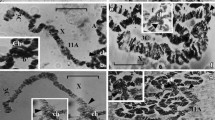Abstract
Structural mutants of the W chromosome that are kept in laboratory strains are described using light and electron microscopic techniques. The series comprises a translocation, a deficiency, fusions, and W fragments. — Conclusions drawn from the mutants are the following: At least one half of the W serves no vital function and is dispensable. Female sex determination, if the W is involved at all, rests on the other half. The amount and form of heterochromatin in somatic interphase nuclei depends on the amount and location of the W chromosome material. The W inactivation in somatic cells does not spread to attached autosomal segments.
Similar content being viewed by others
References
Bauer, H., 1967. Die kinetische Organisation der Lepidopteren-Chromosomen. Chromosoma 22: 102–125.
Caspari, E. W. & Gottlieb, F. J., 1975. The mediterranean meal moth Ephestia kühniella. In: King R. C. (ed.), Handbook of genetics, vol. 3, p. 125–147. Plenum Press, New York.
Cattanach, B., 1974. Position effect variegation in the mouse. Genet. Res. 23: 291–306.
Clarke, C., Mittwoch, U. & Traut, W., 1977. Linkage and cytogenetic studies in the swallowtail butterflies Papillo polyxenes Fab. and Papilio machaon L. and their hybrids. Proc. R. Soc. B. 198: 385–399.
Ennis, T. J., 1976. Sex chromatin and chromosome numbers in Lepidoptera. Can. J. Genet. Cytol. 18: 119–130.
Frizzi, G., 1948. L'eteropicnosi come indice de rinoscimento dei sessi in Bombyx mori L. Ricerca scient. 18: 119–123.
Lindsley, D. L. & Grell, E. H., 1968. Genetic variations of Drosophila melanogaster. Carnegie Inst. Washington Publ. No. 627.
Miller, O. L. Jr. & Bakken, A. H., 1972. Morphological studies of transeription. Karolinska Symp Res Meth reprod Endocrinology. 5th Symposium.
Moses, M. J. & Poorman, P. A., 1981. Synaptonemal complex analysis of mouse chromosomal rearrangements. II. Synaptic adjustment in a tandem duplication. Chromosoma 81: 519–535.
Rathjens, B., 1974. Zur Funktion des W-Chromatins bei Ephestia kuehniella (Lepidoptera). Isolierung und Charakterisierung von W-Chromatin-Mutanten. Chromosoma 47: 21–44.
Sachs, L., 1972. Statistiche Methoden. 2. Auflage. Springer-Verlag, Heidelberg.
Schultz, J., 1936. Variegation in Drosophila and the inert chromosome regions. Proc. natn. Acad. Sci. U.S.A. 22: 21–44.
Schulz, H.-J. & Traut, W., 1979. The pachytene complement of the wildtype and a chromosome mutant strain of the flour moth, Ephestia kuehniella (Lepidoptera). Genetica 50: 61–66.
Seiler, J., 1914. Das Verhalten der Geschlechtschromosomen bei Lepidopteren. Nebst einem Beitrag zur Kenntnis der Eireifung, Samenreifung und Befruchtung. Arch. Zellforsch. 13: 159–269.
Seiler, J., 1959. Untersuchungen über die Entstehung der Parthenogenese bei Solenobia triquetrella F.R. (Lepidoptera, Psychidae). 1. Mitteilung: Die Cytologie der bisexuellen S. triquetrella, ihr Verhalten und ihr Sexualverhältnis. Chromosoma 10: 73–114.
Smith, S. G., 1945. Heteropycnosis as a means of diagnosing sex, J. Hered. 36: 195–196.
Strunnikov, V., 1975. Sex control in silkworms. Nature 255: 111–113.
Suomalainen, E., 1969. On the sex chromosome trivalent in some Lepidoptera females. Chromosoma 28: 298–308.
Tazima, Y., 1964. The genetics of the silkworm. Academic Press, London.
Traut, W., 1976. Pachytene mapping in the female silkworm, Bombyx mori L. (Lepidoptera). Chromosoma 58: 275–284.
Traut, W., 1981. Retarded development of females, a case of maternal inheritance in a moth, Ephestia kuehniella. Genet. Res. 37: 47–53.
Traut, W., 1986. A genetic linkage study of W-chromosome-autosome fusions, breakage, and kinetic organization of chromosomes in Eprestia (Lepidoptera). Genetica 69: 69–79.
Traut, W. & Mosbacher, G. C., 1968. Geschlechtschromatin bei Lepidopteren. Chromosoma 25: 343–356.
Traut, W. & Rathjens, B., 1973. Das W-Chromosom von Ephestia kuehniella (Lepidoptera) und die Ableitung des Geschlechtschromatins. Chromosoma 41: 437–446.
Traut, W. & Scholz, D., 1978, Structure, replication and transcriptional activity of the sex-specific heterochromatin in a moth. Expl Cell Res. 113: 85–94.
Weith, A. & Traut, W., 1980. Synaptonemal complexes with associated chromatin in a moth, Ephestia kuehniella Z. The fine structure of the W chromosomal heterochromatin. Chromosoma 78: 275–291.
Weith, A. & Traut, W., 1986. Synaptic adjustment nonhomologous pairing, and non-pairing of homologous segments in sex chromosome mutants of Ephestia kuelmiella (Insecta, Lepidoptera). Chromosoma (in press).
Author information
Authors and Affiliations
Rights and permissions
About this article
Cite this article
Traut, W., Weith, A. & Traut, G. Structural mutants of the W chromosome in Ephestia (Insecta, Lepidoptera). Genetica 70, 69–79 (1986). https://doi.org/10.1007/BF00123216
Received:
Accepted:
Issue Date:
DOI: https://doi.org/10.1007/BF00123216




